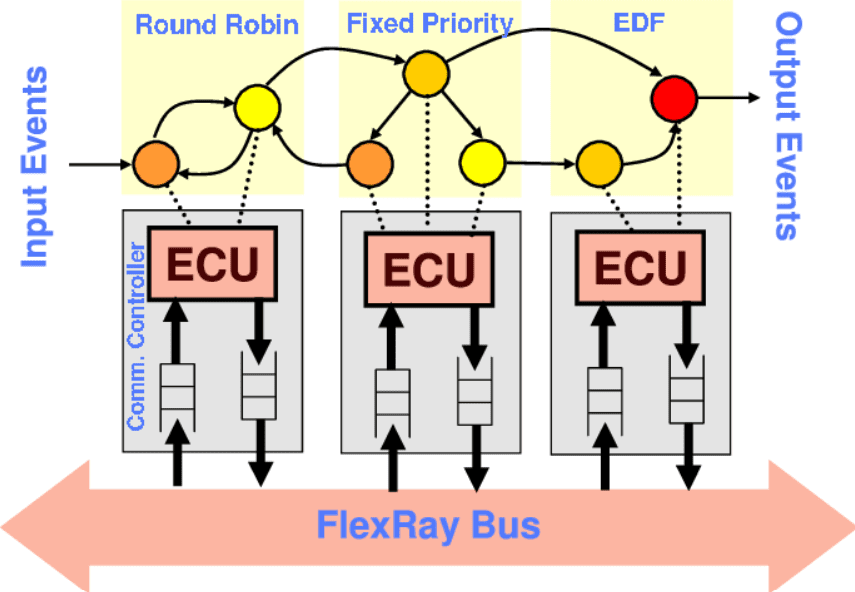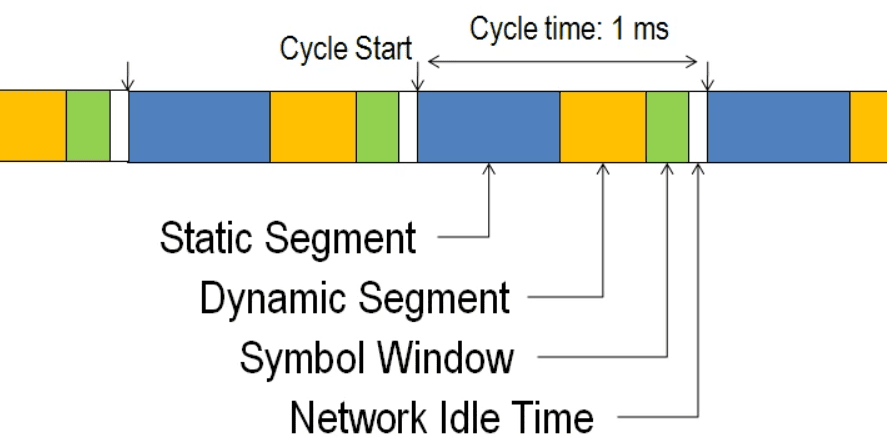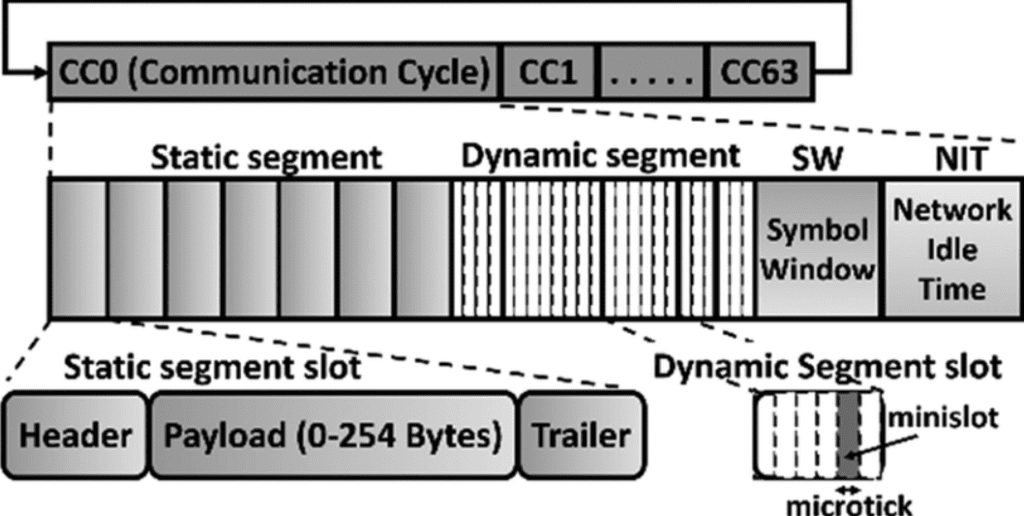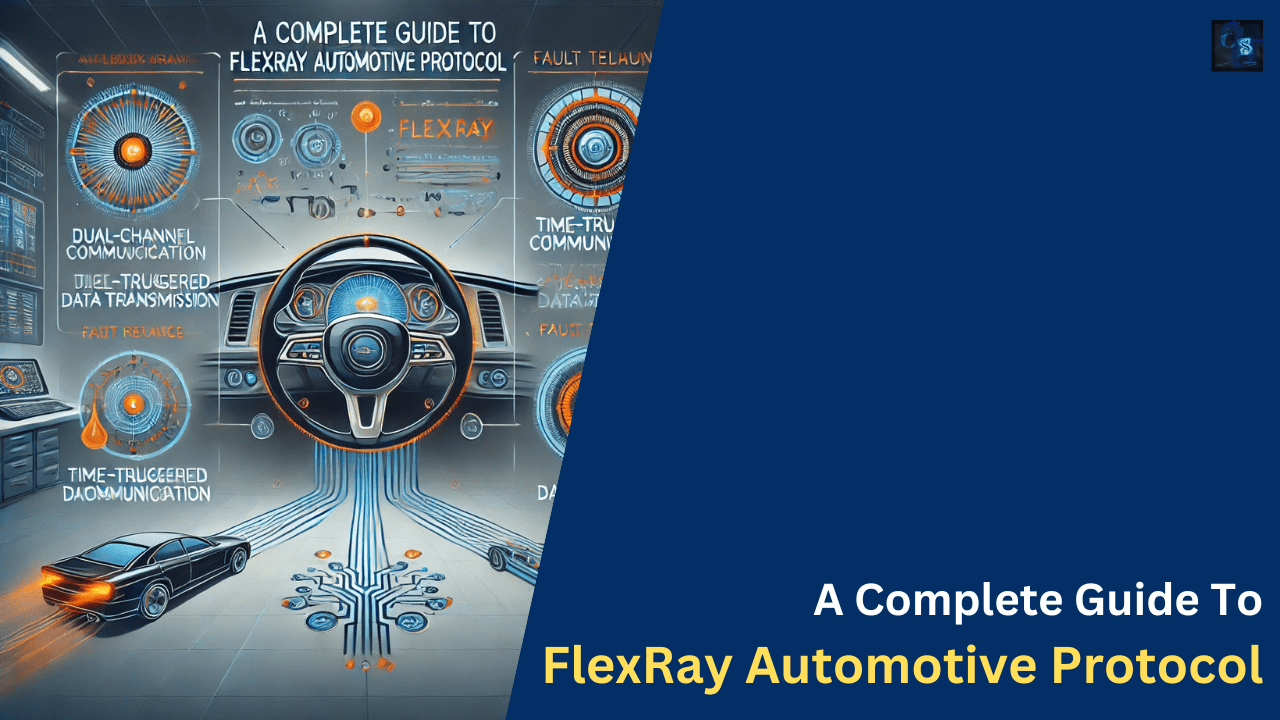A Complete Guide To FlexRay Automotive Protocol
Hello guys, welcome back to our blog. Here in this article, we will discuss FlexRay automotive protocol, its features, communication cycle, structure, and advantages.
Ask questions if you have any electrical, electronics, or computer science doubts. You can also catch me on Instagram – CS Electrical & Electronics
- EV Battery Recycling: Challenges and Future Solutions
- Importance Of Pressure Release & Venting Mechanisms In EV Batteries
- How Blockchain Can Improve Automotive Data Security
FlexRay Automotive Protocol
FlexRay is a high-speed, deterministic, and fault-tolerant communication protocol designed for automotive applications. It is primarily used in safety-critical systems such as advanced driver assistance systems (ADAS), electronic stability control (ESC), and powertrain control. Developed by the FlexRay Consortium (comprising major automotive manufacturers like BMW, Daimler, and Bosch), FlexRay aims to overcome the limitations of Controller Area Network (CAN) and Local Interconnect Network (LIN).
Key Features of FlexRay
- High-Speed Communication – Supports data rates up to 10 Mbps, much faster than CAN.
- Deterministic Timing – Uses time-triggered communication to ensure predictable data transmission.
- Fault Tolerance – Supports dual-channel redundancy for increased reliability.
- Scalability – Can be used for simple as well as complex automotive networks.
- Synchronization – Ensures accurate timing for distributed control systems.
- Hybrid Communication – Supports both time-triggered and event-triggered messages.
FlexRay Network Architecture

The FlexRay protocol is based on a distributed, deterministic architecture with key components:
01. FlexRay Nodes
Each node consists of:
- Microcontroller – Processes and generates data.
- FlexRay Communication Controller (CC) – Manages communication.
- Bus Guardian (BG) – Ensures data integrity and prevents erroneous transmissions.
- Transceiver – Converts digital signals into electrical signals for transmission.
02. FlexRay Bus Topologies
FlexRay supports multiple network topologies:
- Star Topology – Uses a central hub for data routing.
- Bus Topology – Nodes are connected along a shared communication line.
- Hybrid Topology – Combination of bus and star topologies.
03. Dual-Channel Communication
FlexRay supports two independent communication channels (Channel A & Channel B), offering:
- Redundant communication for fault tolerance.
- Increased bandwidth by allowing parallel data transfer.
FlexRay Communication Cycle

The FlexRay cycle consists of fixed time slots to ensure determinism. It includes:
01. Static Segment (Time-Triggered)
- Uses predefined time slots.
- Suitable for periodic and deterministic data.
02. Dynamic Segment (Event-Triggered)
- Allocates bandwidth based on demand.
- Used for aperiodic messages.
03. Symbol Window
- Synchronization information for network nodes.
- Helps in node startup and clock correction.
04. Idle Time
- Ensures proper network synchronization and prevents message collisions.
FlexRay Frame Structure

FlexRay frames consist of the following components:
- Header – Contains frame ID, payload length, and cycle count.
- Payload – Contains actual data (up to 254 bytes).
- Trailer – Includes a Cyclic Redundancy Check (CRC) for error detection.
Synchronization in FlexRay
FlexRay uses a Global Time Synchronization mechanism where:
- Each node adjusts its local clock based on Sync messages.
- Synchronization ensures real-time data consistency.
FlexRay Vs CAN Vs LIN
| Feature | FlexRay | CAN | LIN |
| Speed | Up to 10 Mbps | 1 Mbps | 20 kbps |
| Determinism | Yes | No | No |
| Redundancy | Dual-channel | Single-channel | Single-channel |
| Fault Tolerance | High | Medium | Low |
| Use Case | Safety-critical | General ECU | Low-cost nodes |
Advantages of FlexRay
- Predictable Timing: Ensures deterministic data transfer.
- Higher Bandwidth: Supports large data transfer rates.
- Fault Tolerance: Dual-channel redundancy enhances reliability.
- Scalability: Suitable for different automotive applications.
- Hybrid Communication: Supports both static and dynamic scheduling.
Applications of FlexRay
- Advanced Driver Assistance Systems (ADAS) – Ensures real-time response in safety features like lane-keeping assist.
- Brake-by-Wire and Steer-by-Wire – Eliminate the need for mechanical linkages.
- Powertrain Control – Synchronizes engine and transmission operations.
- Chassis Control – Used in active suspension and electronic stability control (ESC).
- Autonomous Vehicles – Supports complex data exchange required for self-driving cars.
Challenges and Limitations of FlexRay
- Higher Cost: Expensive compared to CAN and LIN.
- Complex Implementation: Requires sophisticated software and hardware.
- Limited Flexibility: Strict timing constraints may not suit all applications.
Example Code for FlexRay Communication
Here is an example of a basic FlexRay node implementation in C:
#include <stdio.h>
#include "flexray.h" // Hypothetical FlexRay library
void sendFlexRayMessage() {
FlexRayFrame frame;
frame.header.frameID = 1;
frame.payload.length = 8;
frame.payload.data[0] = 0xAA;
frame.payload.data[1] = 0xBB;
frame.payload.data[2] = 0xCC;
frame.payload.data[3] = 0xDD;
frame.payload.data[4] = 0xEE;
frame.payload.data[5] = 0xFF;
frame.payload.data[6] = 0x11;
frame.payload.data[7] = 0x22;
if (FlexRay_SendFrame(&frame) == 0) {
printf("FlexRay message sent successfully!\n");
} else {
printf("Error sending FlexRay message.\n");
}
}
int main() {
FlexRay_Init(); // Initialize FlexRay communication
sendFlexRayMessage();
return 0;
}
Future of FlexRay
Despite the emergence of Ethernet-based automotive networks, FlexRay remains a preferred choice for time-critical applications. However, the trend is shifting towards Automotive Ethernet due to its higher bandwidth and flexibility.
Conclusion
FlexRay is a robust, high-speed, and fault-tolerant communication protocol designed for automotive applications. With its deterministic time-triggered communication and dual-channel redundancy, it plays a critical role in modern vehicle networks.
While Automotive Ethernet is gaining popularity, FlexRay continues to be an essential protocol for safety-critical applications like ADAS, brake-by-wire, and powertrain control. Understanding FlexRay is crucial for automotive engineers working on next-generation vehicle communication systems.
This was about “FlexRay Automotive Protocol“. Thank you for reading.
Also, read:
- 100 (AI) Artificial Intelligence Applications In The Automotive Industry
- 1000+ Automotive Interview Questions With Answers
- 2024 Is About To End, Let’s Recall Electric Vehicles Launched In 2024
- 50 Advanced Level Interview Questions On CAPL Scripting
- 7 Ways EV Batteries Stay Safe From Thermal Runaway
- 8 Reasons Why EVs Can’t Fully Replace ICE Vehicles in India
- A Complete Guide To FlexRay Automotive Protocol
- Adaptive AUTOSAR Vs Classic AUTOSAR: Which One For Future Vehicles?

